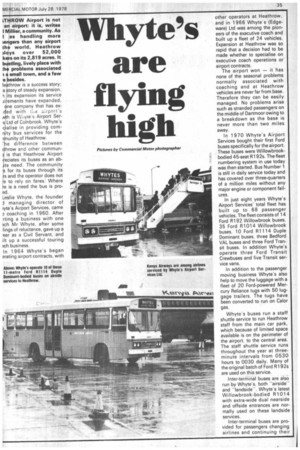Wh yte 's
Page 37

If you've noticed an error in this article please click here to report it so we can fix it.
are fl high
Pictures by Commercial Motor photographer
irimovv Airport is not an airport: it is, writes I IVIillier, a community. As
I as handling more cei gers than any airport th world, Heathrow )1 'ys over 52,000 k on its 2,819 acres. It bt4stling, lively place with th problems associated 1 small town, and a few e besides.
le throw is a success story; a tory of steady expansion. 1 its expansion its service il ements have expanded,
ne company that has ex
ed with ti.e ;:;-port's h is W:iyte's Airport Ser
si Ltd of Colnbrook. Whyte's qialise in providing comnIity bus services for the ifriunity of Heathrow.
e difference between i hrow and other communis that Heathrow Airport eciates its buses as an abte need. The community for its buses through its s and the operator does not e to rely on fares. Where re is a need the bus is proed.
Leslie Whyte, the founder i managing director of lyte's Airport Services, came 3 coaching in 1960. After rting a business with one ich Mr Whyte, after some lings of reluctance, gave up a .eer as a Civil Servant, and ilt up a successful touring tch business.
In 1964 Whyte's began crating airport contracts, with other operators at Heathrow, and in 1966 Whyte's (Edgeware) Ltd was among the pioneers of the executive coach and built up a fleet of 24 vehicles.
Expansion at Heathrow was so rapid that a decision had to be made whether to specialise on executive coach operations or airport contracts.
The airport won — it has none of the seasonal problems normally associated with coaching and at Heathrow vehicles are never far from base.
Therefore they can be easily managed. No problems arise such as stranded passengers on the middle of Dartmoor owing to a breakdown as the base is never more than two miles away.
In 1970 Whyte's Airport Services bought their first Ford buses specifically for the airport. These buses were Willowbrookbodied 45-seat R1 92s. The fleet numbering system in use today was then started. Bus Number 1 is still in daily service today and has covered over three-quarters of a million miles without any major engine or component failures.
In just eight years Whyte's Airport Services' total fleet has built up to 68 passenger vehicles. The fleet consists of 14 Ford R192 Willowbrook buses, 35 Ford R1014 Willowbrook buses, 10 Ford R1114 Duple Dominant buses, three Bedford VAL buses and three Ford Transit buses. In addition Whyte's operate three Ford Transit Crewbuses and five Transit service vans.
In addition to the passenger moving business Whyte's also help to move the luggage with a fleet of 20 Ford-powered Mercury Reliance tugs with 50 lug gage trailers. The tugs have been converted to run on Calor gas.
Whyte's buses run a staff shuttle service to run Heathrow staff from the main car park, which because of limited space available is on the perimeter of the airport, to the central area. The staff shuttle service runs throughout the year at threeminute intervals from 0530 hours to 0030 daily. Many of the original batch of Ford R1 92s are used on this service.
Inter-terminal buses are also run by Whyte's, both "airside" and "landside". Whyte's latest Willowbrook-bodied R1014 with extra-wide dual nearside and offside entrances are normally used on these landside services.
Inter-terminal buses are provided for passengers changing airlines and continuing their




























































































